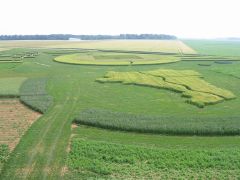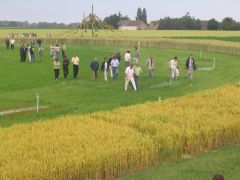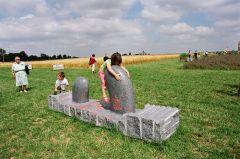| |

 
  |

 
|
> At the
beginning of the interview, you told me that human beings
(including the artist) should have a more humble attitude
towards nature. Paradoxically you seem to go for bigger
and bigger sculptures, land art, in which humans get lost.
_ I am not megalomaniac. I do not ignore human kind as the
scale of my work expands. I want to demonstrate the power
of nature, and the scale helps doing that. Nature is more
important than humans, nature is the condition of our existence,
without us the planet would still go on spinning. When you
watch my land art realisations from the sky you can really
get a feel for its size, and on the ground you are not overwhelmed
by it. As you walk through them, you experience a very strong
contact with vegetation, you are immersed and in contact
with materials like in my other immersive sculptures.
>インタビューの最初に、あなたは人(芸術家も含めて)が自然に対して、より謙遜な態度を取らなければならないと言っています。逆説的に、あなたはどんどん、ランドアートの様に迷ってしまいそうな、広く、より大きい彫刻を制作したい様に見えますが。
_ 私は、誇大妄想狂ではありません。仕事が拡大して来ても、人を無視しません。私は自然の力を強調したいのです、大きなスケールはその意味でより強調されます
。自然はずっと人間より重要です、自然は我々の存在する条件です、我々なしでも、惑星はまだ回転します。空から自分のランドアートの作品を見ると、大変な仕事だと思えますが、地上ではそんなに呑み込まれる程の仕事だとは感じません。
散策していると、植物との間にとても強い接触を得ます。私の他の水に沈んだ作品の様に、物質とのコンタクトにより私たちはそこに浸りきってしまいます。
> Au début de l’interview, tu me disais
qu’il faut que l’homme (y compris l’artiste) ait une attitude
plus humble par rapport à la nature. Paradoxalement tu
sembles vouloir faire des œuvres de plus en plus grandes,
du land art, dans lesquelles l’homme se perd.
_ Je ne suis pas mégalomane. Je n’ignore pas l’homme dans
mon travail qui devient de plus en grand. Je veux faire
la démonstration de la puissance de la nature, et l’échelle
aide. La nature est beaucoup plus importante que les hommes,
la nature est la condition de l’existence des humains,
sans nous la terre continuerait à tourner. Quand on regarde
mes land-arts du ciel, on constate la grandeur du travail;
au sol on ne se sent pas engloutit par les dimensions du
travail. Dans les parcours, on a un contact physique fort
avec les végétaux, on est immergés et en contact avec la
matière comme dans mes autres sculptures immersives.
|
 |
 |
 |
 |
 |
|
| |
|
|
 |
> So why do you call
this “sculpture” instead of “garden” ?
_ Yes, call it “garden” if you feel better with this word.
I consider the planet as a global art piece, I see architecture
as a bas-relief, natural landscapes as surface works on earth.
Now let’s add the idea of time, the lively aspect, in motion,
the seasons and their colours, like a bas-relief, painted
and alive.
Maybe I am influenced by Japanese and French gardens. In
a Japanese garden, one tries to copy existing nature in a
very controlled way. In a French garden, one dominates nature
and imposes one’s own design. Shapes and the natural materials
are my means of expression. Nature used to be the subject,
now it is the media I use to express myself.
> どうして、あなたは「庭」と言わないで、「彫刻」と呼ぶのですか
?
_ はい、もしそっちの方が良いならば、それを「庭」と呼んでください。私は惑星を宇宙的な芸術作品と思っています。私は建築を地球上のレリーフだと思っているし、自然の風景等はこの地球上の表面処理と思っています。風景と時間、生きた事実、動き、季節とその色、色を塗った生き生きしたレリーフの様に思っています。
私は、日本庭園、フランス庭園の影響を受けています。日本の庭はコントロールされた自然を人間が出来るだけ巧くコピーをする、フランスの庭は人間が全て自然をコントロールしてその形迄も強制する。私は、形を表現したいと思っています。素材は特に表現する為の、基材です。そして、今迄は自然が主題でしたが、今は自然が表現する為の媒体(メディア)として使われます。
> Mais alors pourquoi appeler ça «sculpture», au lieu
de «jardin» ?
_ Oui, appelle ça « jardin » si tu préfères. Je considère
la sphère terrestre comme un ensemble, une œuvre d’art
globale. Je perçois l’architecture comme un bas-relief,
les paysages naturels comme des traitements de surface
de cette terre. Ajoutons maintenant le passage du temps,
l’aspect vivant, en mouvement, les saisons et ses couleurs,
comme un bas-relief peint et vivant.
Je suis peut-être imprégné des jardins japonais et français.
Le jardin japonais: l’homme essaie de copier la nature
qui existe de façon très contrôlée; dans le jardin français
l’homme domine la nature et applique son dessin. J’ai envie
de montrer des formes, le matériau naturel c’est surtout
un support d’expression. Avant la nature était le sujet,
maintenant la nature est le support d’expression, le média.
|
 |
 |
  |
  |
  |


|
 
|
 
|
 |
  |
| |
|
 |
 |
> In your second land
art experimentation, you reproduce a map of Europe and
of the Beauce, the area where you work. The creativity
of the artist seems only in the background, taking second
place to cartographic considerations.
_ It was a request from my partners, other actors of the
Beauce fields. We were serving a political cause, celebrating
a 25-member Europe. The content is political, I was a kind
of designer on this project, doing scenography rather than
fine-art. I did put sculptures inside the land art, as warmer
and more poetical presences.
> あなたの二度目のランドアートの試みでは、ヨーロッパの地図と、そして、あなたのアトリエのある地域、ボース地方の地図を再現しています。アーティストの創造的な部分は、地図の後になってしまい、あまり重要ではないようですが?
_ それは、私の「ボースの畑」のパートナーからの要請です。我々は25ヵ国のヨーロッパメンバーに賛同する政治的な目的も含めて活動しています。それは政治です。私はデザイナーの仕事の様に、彫刻家と言うより、むしろ舞台美術家的な仕事をしています。それでも、より詩的存在感をあたえる彫刻も其所に設置しました。
> Dans ta deuxième expérimentation land art, l’œuvre
reproduit une carte de l’Europe et de la Beauce, la région
où tu travailles. La part de création de l’artiste semble
passer au second plan derrière une forme cartographique.
_ C’est à la demande des autres acteurs des champs de la
Beauce. Nous servons une cause politique, nous célébrons
l’Europe à 25. Le contenu est politique, je m’occupe de
sa mise en scène sensible, j’ai plutôt un rôle de designer
; scénographe plutôt que plasticien ici. J’ai quand même
peuplé le land-art de sculptures qui sont des présences
plus poétiques.
|
 |
 |
 |
 |
 |
 |
 |
 |
 |
 |
  |
  |
  |
  |
  |
  |
 |
|
| |
|
|
|
|
|
|
|